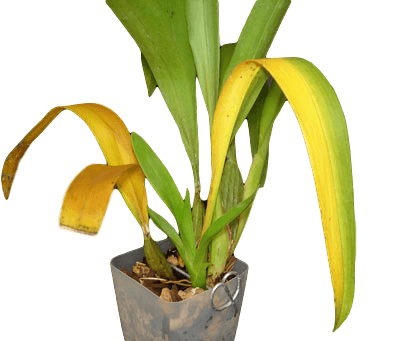Too much sun

The main cause of orchid leaves turning yellow is overwatering. This is not a good thing because it kills the plant from the roots up. Before you even realize that your orchid has become sick, the roots start to rot and turn black. The best way to save your plant from this condition is to place it in a well-ventilated area. This will allow the orchid more air flow and avoid bacterial or fungal infections.
Another common cause of orchid leaves turning yellow is a nutrient deficiency. After the plant absorbs all of the nutrients from the potting mix, it may need fertilizer. Buy a fertilizer that is formulated for orchids, and make sure to follow the instructions on the label. Because orchids are light feeders, they do not require as much fertilizer as many other plants, but they can benefit from regular fertilization.
Too much sunlight can also cause orchid leaves to turn yellow. If you are growing your orchid in direct sunlight, the bright light from the sun can burn the leaves, causing them to turn yellow or brown. It will also cause scorch marks and cracks on the leaves. It may be necessary to move your orchid to indirect sunlight for a few hours each day.
Too little water
If you want to keep orchids looking their best year-round, make sure you don’t overwater them. While orchids need a stable temperature, too much or too little water can damage the leaves and stunt growth. However, the good news is that yellowed leaves can be easily replaced with new ones, so you don’t need to worry about having to remove them. Just make sure that your orchid’s room has a thermostat that keeps the temperature from dropping below 60 degrees F, and that it’s away from any cold drafts. Fertilising your orchid is also important to ensure that it’s healthy, but be careful not to over-fertilize it.
If you do notice that your orchids’ leaves have turned yellow or black, it might be time to increase their water levels. You can do this by adding a few drops of water each time you water. Make sure that the watering level matches the type of orchid that you have.
Nutritional deficiency
Orchids can show signs of nutrient deficiency if they do not receive enough calcium and magnesium in their soil. The plants can also have brown or black leaf tips. If this is the case, you should take steps to fix the problem as quickly as possible. You can start by feeding the plant with Cal Mag solution. Apply it once a week for three weeks. After that, you can observe improvements in the leaves. Moreover, if you see that the calcium and magnesium levels are lower than normal, you may have to give them additional feedings to make them healthy.
Orchids can suffer from different kinds of diseases, including fungus and virus. These conditions are hard to detect and treat. The main symptoms of these diseases are different and may be confused with one another.
Pests or disease
If you notice the leaves of your orchids turning yellow, you must immediately identify the cause. A common culprit is a fungal or bacterial infection. A fungal infection will cause the leaves to turn yellow, and bacterial rot will cause the leaves to turn black. Fortunately, you can prevent the problem from spreading by using the proper treatment.
The first thing you must do is check your orchid’s water source. Tap water can have high levels of magnesium and calcium, which are harmful to orchids. The high levels of these minerals can cause the leaves to turn yellow. In addition, hard water can also be harmful to the plant’s ability to absorb micronutrients.
In addition to pests, other common orchid problems include bacterial and fungal diseases. Fungal diseases are typically caused by overwatering. To prevent bacterial infections, you must remove infected leaves before they wilt. You can also apply a fungicide if you suspect a bacterial infection.
